- Treatment of Strawberries from Pests: Effective Methods and Organic Solutions
- 1. Prevention
- 2. Biological Control
- 3. Organic Pesticides
- Conclusion
- Natural Predators: Beneficial Insects and Birds
- 1. Ladybugs
- 2. Lacewings
- 3. Hoverflies
- 4. Birds
- Cultural Practices: Crop Rotation and Sanitation
- Physical Barriers: Netting and Mulching
- Netting
- Mulching
- Biological Controls: Nematodes and Microorganisms
- Nematodes
- Microorganisms
- Organic Sprays: Neem Oil and Diatomaceous Earth
- Neem Oil
- Diatomaceous Earth
- Conclusion
- Integrated Pest Management: Monitoring and Thresholds
- Monitoring Techniques
- Thresholds
- Traps and Lures: Pheromone Traps and Sticky Traps
- Pheromone Traps
- Sticky Traps
- Using Traps and Lures for Integrated Pest Management
- Companion Planting: Deterrent Plants and Attractant Plants
- Deterrent Plants:
- Attractant Plants:
- Question-answer:
- What are the common pests that attack strawberries?
- Are there any organic methods to control pests on strawberries?
- What are some effective chemical treatments for pests on strawberries?
- How can I prevent pests from attacking my strawberries?
- Are there any natural predators that can help control pests on strawberries?
- Video: Growing Strawberries (Part 2): Pruning, Pests, and Harvesting
Strawberries are delicious and nutritious fruits that are loved by many people around the world. However, these delicate berries are susceptible to various pests that can damage the plants and reduce the yield. In order to protect your strawberry plants and ensure a healthy crop, it is important to implement effective methods of pest control.
There are several common pests that can affect strawberries, such as aphids, slugs, snails, and spider mites. These pests not only feed on the leaves and fruits of the plants, but they can also transmit diseases, such as viruses and fungi, which can further harm the crop. Therefore, it is essential to take proactive measures to control these pests.
One effective method of pest control is the use of organic solutions. Organic pesticides, such as neem oil and insecticidal soaps, can help to eliminate pests without causing harm to the environment or the plants themselves. These natural solutions work by disrupting the pests’ life cycle and preventing them from reproducing. They are safe to use and can be applied directly onto the plants without causing harm to beneficial insects or pollinators.
In addition to organic solutions, there are also cultural practices that can help to prevent and control pests on strawberry plants. These include removing weeds and debris from the garden, as they can provide hiding places for pests. It is also important to practice crop rotation and avoid planting strawberries in the same location year after year, as this can lead to a buildup of pests and diseases in the soil.
In conclusion, the treatment of strawberries from pests requires a combination of effective methods and organic solutions. By implementing these strategies, you can protect your strawberry plants from pests and ensure a healthy crop. Remember to regularly inspect your plants for signs of pests, and take action immediately if any are detected. With proper care and attention, you can enjoy a bountiful harvest of delicious strawberries.
Treatment of Strawberries from Pests: Effective Methods and Organic Solutions
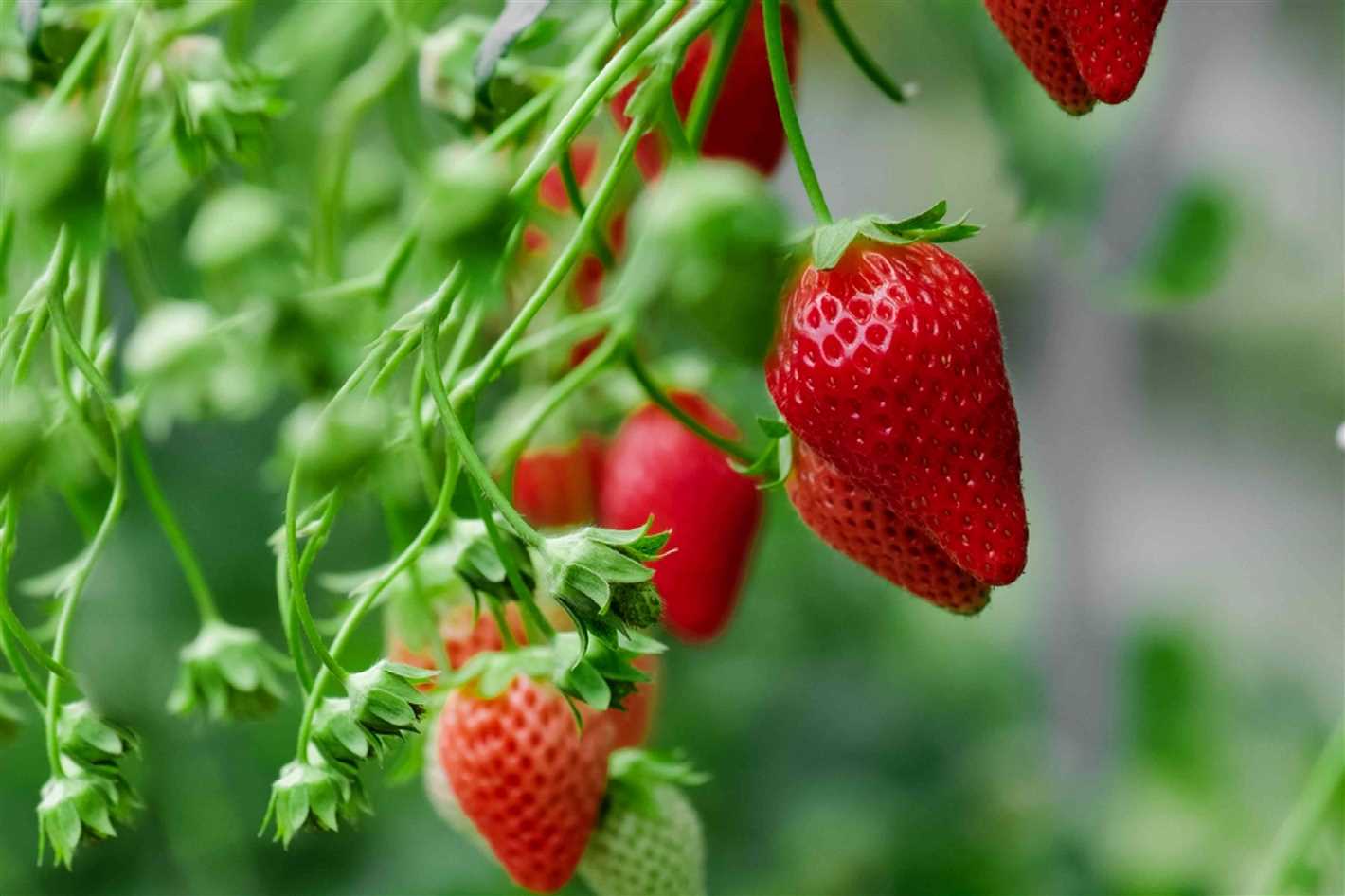
Strawberries are delicious and nutritious fruits that are beloved by many. However, they are also vulnerable to various pests that can damage the plants and reduce the quality of the fruits. In this article, we will discuss effective methods and organic solutions for treating strawberries from pests.
1. Prevention
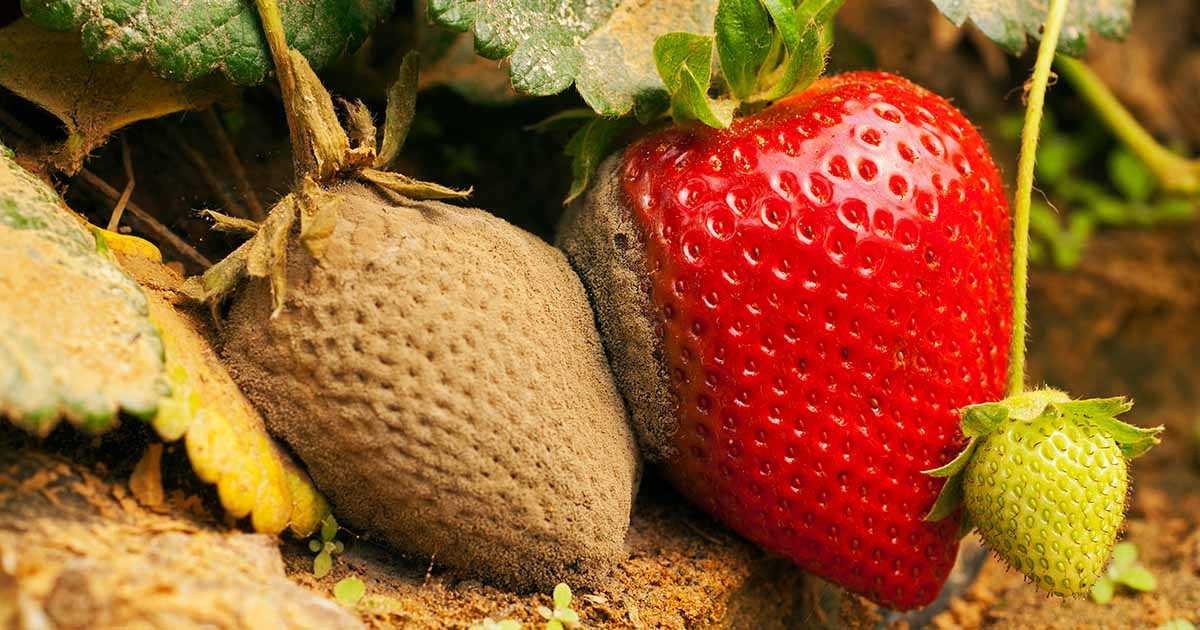
Prevention is the first line of defense against pests. By implementing good cultural practices, you can reduce the likelihood of a pest infestation. Here are some preventive measures:
- Proper site selection: Choose a well-drained area with plenty of sunlight for your strawberry plants. Avoid planting them in areas prone to waterlogging or excessive shade.
- Clean cultivation: Clear the planting area of weeds, debris, and old plant material that may harbor pests.
- Crop rotation: Avoid planting strawberries in the same spot every year. Rotate them with other crops to disrupt pest life cycles.
- Sanitation: Regularly remove and destroy any infected or diseased plant material to prevent the spread of pests.
2. Biological Control
Biological control involves the use of natural enemies to suppress pest populations. There are several beneficial insects and organisms that can help control strawberry pests. Here are some examples:
- Ladybugs: Ladybugs and their larvae feed on aphids, which are a common pest of strawberries.
- Parasitic wasps: Certain species of parasitic wasps lay their eggs on pests like caterpillars and aphids, eventually killing them.
- Nematodes: Beneficial nematodes can be used to control soil-dwelling pests like root-knot nematodes.
- Predatory mites: Predatory mites can feed on small arthropod pests like spider mites, thrips, and whiteflies.
3. Organic Pesticides
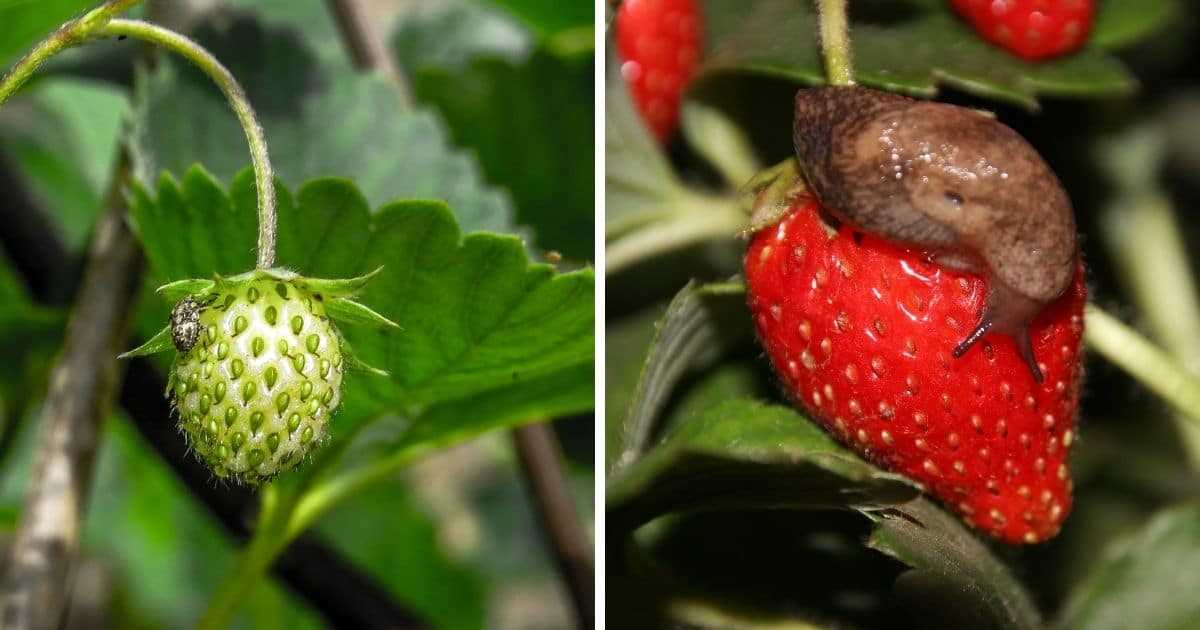
If preventive and biological control measures are not sufficient, organic pesticides can be used as a last resort. However, it is important to choose organic pesticides that are approved for use on strawberries and follow the instructions carefully. Here are some organic pesticides that can be effective against strawberry pests:
- Insecticidal soaps: These soaps are made from natural fatty acids and can help control pests like aphids, mites, and thrips.
- Neem oil: Neem oil is derived from the neem tree and acts as an insect repellent and growth regulator against a wide range of pests.
- Pyrethrin: Pyrethrin is a natural insecticide derived from chrysanthemum flowers. It can control a variety of pests, including aphids, beetles, and caterpillars.
- Bacillus thuringiensis: Bacillus thuringiensis (Bt) is a naturally occurring bacterium that produces proteins toxic to certain insect pests, such as caterpillar larvae.
Conclusion
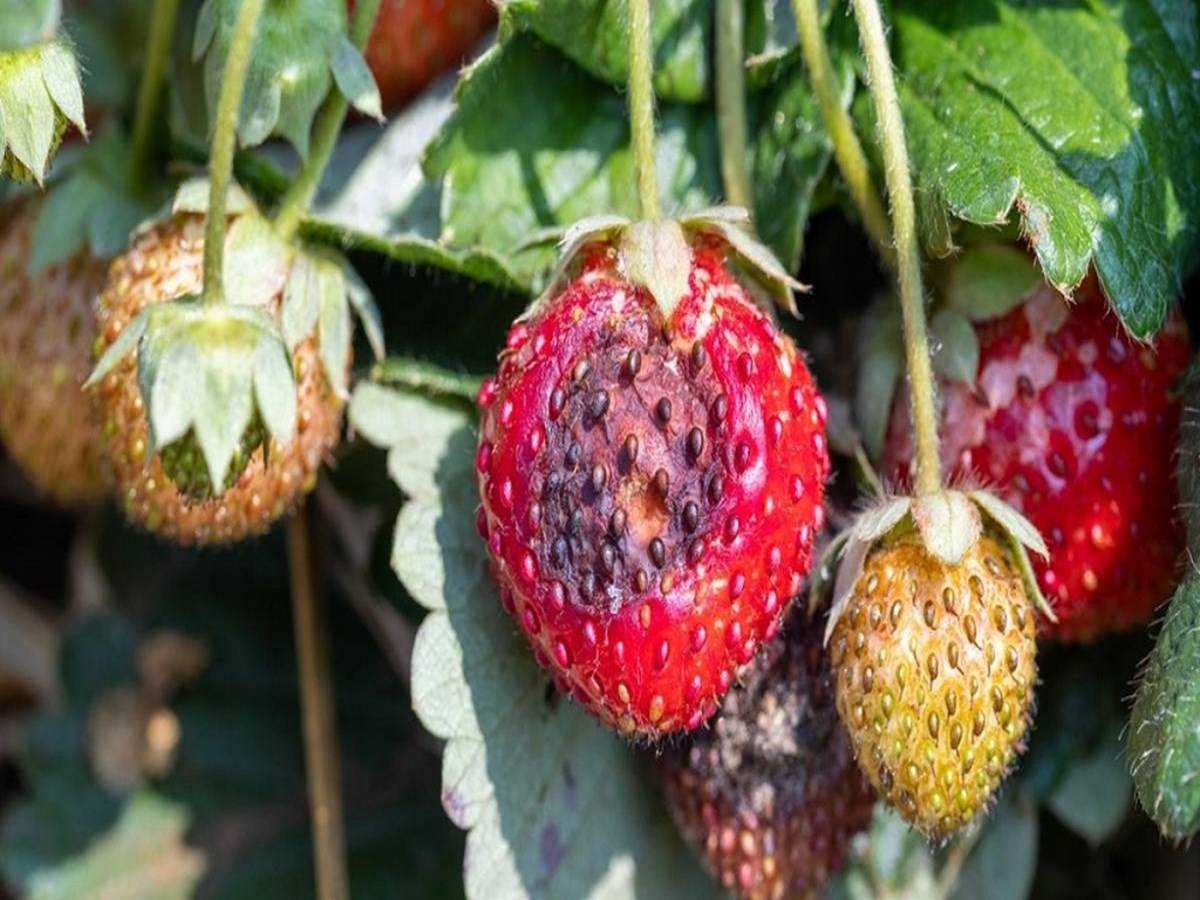
Treating strawberries from pests requires a combination of preventive measures, biological control, and, if necessary, organic pesticides. By implementing these methods and solutions, you can protect your strawberry plants and enjoy a bountiful harvest of healthy, pest-free strawberries.
Natural Predators: Beneficial Insects and Birds
One of the most effective and environmentally friendly ways to control pests in strawberry plants is by encouraging the presence of natural predators. There are several beneficial insects and birds that can help keep pest populations under control, reducing the need for chemical pesticides.
1. Ladybugs
Ladybugs, also known as lady beetles, are voracious eaters of aphids, mites, and other soft-bodied insects that can damage strawberry plants. They are easily recognized by their bright colors and distinctive spots. To attract ladybugs, consider planting flowers such as daisies, marigolds, and yarrow, which provide a source of nectar for their adult stage. Additionally, avoiding the use of broad-spectrum insecticides that can harm ladybugs and their larvae is crucial.
2. Lacewings
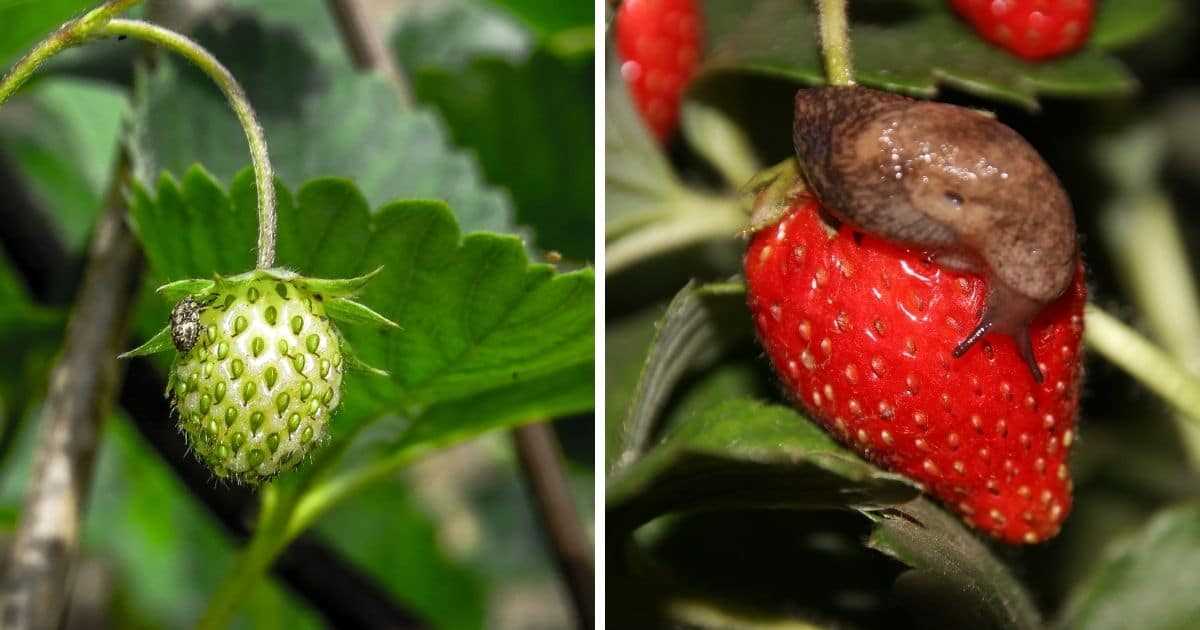
Lacewings are a group of delicate insects with intricate, lacy wings that are highly efficient predators of aphids, thrips, and small caterpillars. They can be attracted to the garden by planting flowers such as dill, coriander, and cosmos, which provide nectar and pollen for the adult lacewings, as well as sheltered areas for them to lay their eggs. Lacewings are very sensitive to chemical pesticides, so it’s important to use organic alternatives if necessary.
3. Hoverflies
Hoverflies, also called flower flies, are beneficial insects that resemble small bees or wasps. They feed on the nectar and pollen of flowers but also consume aphids, mealybugs, and other soft-bodied insects. To attract hoverflies, plant flowers such as sunflowers, asters, and sweet alyssum. These flowers not only provide a food source for the adult hoverflies but also act as a landing platform for the females to lay their eggs.
4. Birds
Several bird species can help control pests in the garden, including strawberries. For instance, sparrows, finches, and warblers feed on a variety of insects, including caterpillars, aphids, and grasshoppers. To attract birds to your garden, provide a water source such as a birdbath, plant trees and shrubs that offer shelter and nesting sites, and avoid using chemical pesticides that can harm birds and their food sources.
By utilizing these natural predators in your strawberry garden, you can create a more balanced ecosystem that reduces the reliance on harmful pesticides, keeping your strawberry plants healthy and pest-free in an environmentally friendly way.
Cultural Practices: Crop Rotation and Sanitation
Crop rotation is a common cultural practice used to control pests in strawberry production. By rotating the location of strawberry beds each year, farmers can disrupt the life cycle of pests and reduce their populations.
One effective method of crop rotation is to alternate strawberry beds with non-susceptible crops, such as corn or wheat. This helps to break the continuous cycle of pests and prevents the buildup of pest populations in the soil. Additionally, planting cover crops like clover or buckwheat during the off-season can further improve soil health and reduce pest pressure.
Sanitation practices are also crucial in preventing pest infestations. Regularly removing and destroying weed hosts can help eliminate potential sources of pests. Weeds provide shelter and food for many strawberry pests, so it is important to keep the field clean and free from any weeds.
Furthermore, removing and destroying any infected or infested plants can help prevent the spread of diseases and pests. Infected plant material should be burned or disposed of properly to ensure that no pests or diseases survive to affect future crops. Cleaning and sanitizing tools and equipment between uses can also help prevent the spread of pests.
Table 1: Crop rotation example:
| Year | Planting |
|---|---|
| Year One | Strawberries |
| Year Two | Corn |
| Year Three | Strawberries |
| Year Four | Wheat |
| Year Five | Strawberries |
Implementing proper crop rotation and sanitation practices can significantly reduce pest problems in strawberry production. By disrupting the life cycle of pests and eliminating potential sources of infestation, farmers can effectively manage pests and ensure the health and productivity of their strawberry crops.
Physical Barriers: Netting and Mulching
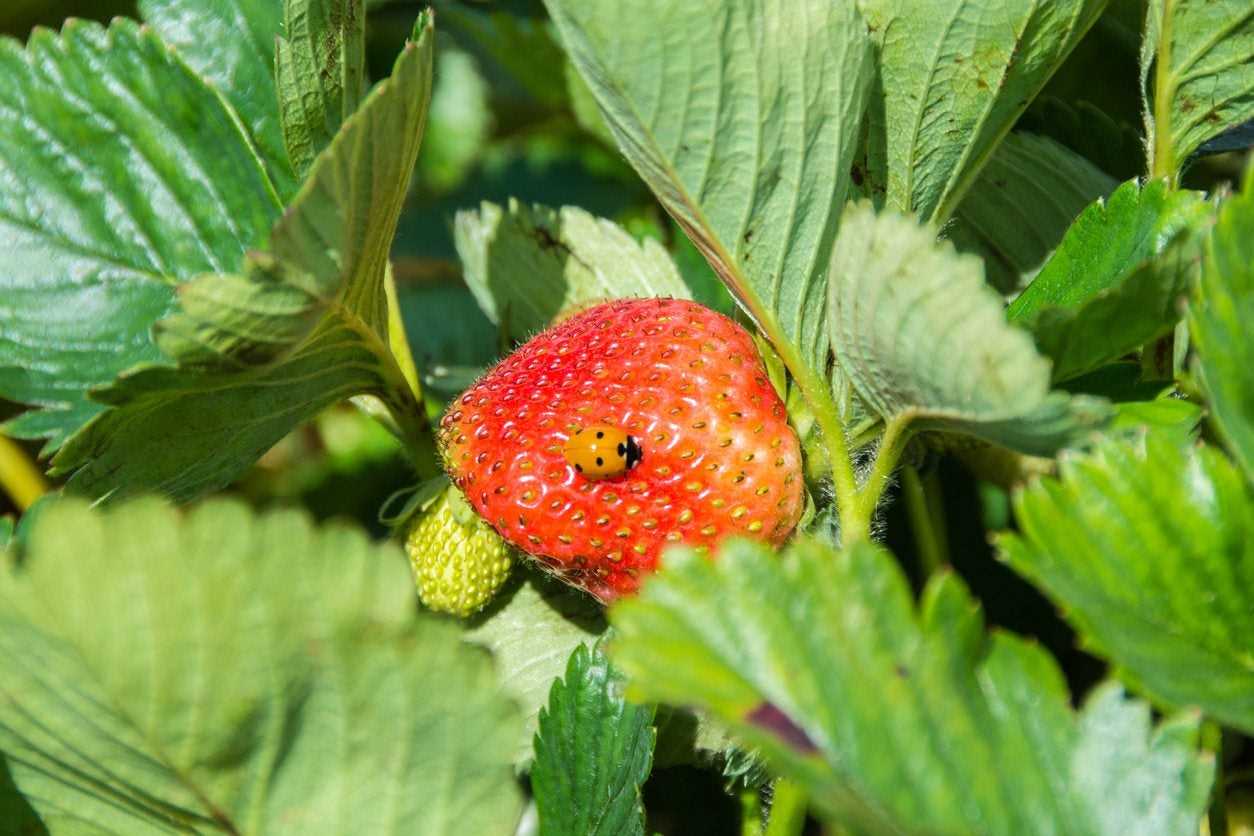
Physical barriers such as netting and mulching can be effective methods to protect strawberries from pests and maintain a healthy crop. These methods provide a physical barrier that prevents pests from reaching the plants and causing damage.
Netting
Netting is commonly used to protect strawberries from birds, insects, and other small pests. It is usually made of a fine mesh material that allows sunlight and water to reach the plants while keeping pests out.
- Choose a netting material with a mesh size that is small enough to prevent pests from passing through.
- Cover the strawberry plants with the netting, creating a protection barrier.
- Secure the netting tightly around the plants, making sure there are no gaps for pests to enter.
- Regularly inspect the netting for any holes or damage, and repair or replace as needed to maintain its effectiveness.
Mulching
Mulching is another effective method to protect strawberries from pests and provide additional benefits to the plants.
- Apply a layer of organic mulch, such as straw or wood chips, around the strawberry plants.
- The mulch acts as a physical barrier, making it difficult for pests to reach the plants.
- Mulching also helps to regulate soil temperature, conserve moisture, and suppress weed growth.
- Make sure to keep the mulch layer thick enough to provide sufficient protection and benefits to the plants.
- Avoid piling mulch directly against the stems of the plants, as it can create a favorable environment for pests and diseases.
By implementing physical barriers such as netting and mulching, strawberry growers can effectively protect their crop from pests and ensure a healthy harvest. These methods are relatively easy to implement and can provide long-lasting protection when properly maintained.
Biological Controls: Nematodes and Microorganisms
Biological controls offer a sustainable and environmentally friendly approach to managing pests in strawberry crops. Two commonly used biological controls are nematodes and microorganisms.
Nematodes
Nematodes are microscopic roundworms that can be used to control certain pests that attack strawberries. One example is the Steinernema feltiae nematode, which is effective against strawberry root weevils and larvae of various insect pests. These beneficial nematodes actively seek out their prey and infect them with bacteria, ultimately leading to the death of the pest.
Applying nematodes to strawberry crops involves mixing them with water and then spraying the solution onto the plants or soil. It is important to follow the instructions provided by the manufacturer to ensure proper application and effectiveness.
Microorganisms
Microorganisms, such as bacteria and fungi, can also be used as biological controls for strawberry pests. Bacillus thuringiensis (Bt) is a commonly used bacterium that produces toxins harmful to certain insects while being harmless to humans and other organisms. Bt can be sprayed onto the strawberry plants to control pests like caterpillars and beetles.
In addition to bacteria, fungi like Trichoderma spp. can be used to control fungal diseases in strawberries. These fungi colonize the plant’s roots and create a protective barrier against pathogens, reducing the risk of infection and disease.
It is important to note that the effectiveness of nematodes and microorganisms as biological controls may vary depending on the specific pest and environmental conditions. Therefore, it is recommended to consult with experts or agricultural extension services for guidance on the most suitable products and application methods for your specific situation.
Organic Sprays: Neem Oil and Diatomaceous Earth
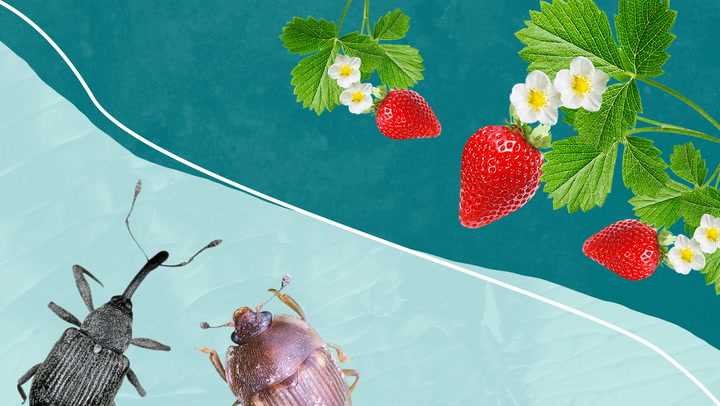
When it comes to treating strawberries for pests, organic sprays can be a highly effective solution. Two popular options are Neem Oil and Diatomaceous Earth.
Neem Oil
Neem oil is a natural plant-based oil that is derived from the neem tree. It has been used for centuries in traditional medicine and is known for its insecticidal properties. Neem oil works by disrupting the life cycle of pests, including aphids, mites, and whiteflies.
To make a neem oil spray, mix two teaspoons of neem oil with one quart of water and a few drops of dish soap. Spray the mixture onto the strawberry plants, focusing on the leaves and stems. It is best to apply the spray in the early morning or late afternoon when the temperatures are cooler.
Neem oil is safe to use around humans and pets, and it is more environmentally friendly compared to chemical pesticides. However, it is important to note that neem oil can also affect beneficial insects. Therefore, it is recommended to use it sparingly and avoid spraying bees and other pollinators.
Diatomaceous Earth
Diatomaceous earth is a fine powder made from the fossilized remains of tiny aquatic organisms called diatoms. It is often used as a natural pesticide for controlling a wide range of pests, including slugs, snails, and caterpillars.
To use diatomaceous earth, sprinkle a thin layer of the powder around the base of the strawberry plants. The sharp edges of the diatomaceous earth particles will pierce the exoskeleton of the pests, causing them to dehydrate and die. Reapply after rain or when the powder becomes wet.
Diatomaceous earth is safe to use around humans and pets, but it is important to choose a food-grade quality product. Avoid inhaling the powder, as it can cause irritation to the respiratory system.
Conclusion
Organic sprays such as neem oil and diatomaceous earth offer effective and environmentally friendly solutions for treating strawberry plants from pests. These natural remedies can help protect your strawberries from common pests without the use of harmful chemicals.
Integrated Pest Management: Monitoring and Thresholds
The success of integrated pest management (IPM) in managing pests on strawberries greatly relies on proper monitoring and timely action. By regularly monitoring the strawberry crop, growers can detect and identify pests early, allowing for effective management strategies to be implemented before the populations become economically damaging.
Monitoring Techniques
There are several monitoring techniques that can be used to track pest populations in a strawberry field:
- Visual Inspection: Regular visual inspection of the plants, leaves, and fruits can help identify signs of pest presence such as feeding damage, eggs, larvae, or adult pests.
- Traps: Using traps is another way to monitor pests. Different types of traps can be placed in the field to attract and capture specific pests. For example, yellow sticky traps can be used to monitor thrips or whiteflies.
- Pheromone Traps: Pheromone traps utilize the release of synthetic sexual pheromones to attract and capture male insects, aiding in the detection and monitoring of certain pests.
- Sampling: Sampling techniques, such as sweep netting or beating tray sampling, involve physically collecting insects from the plants for identification and population assessment.
Thresholds
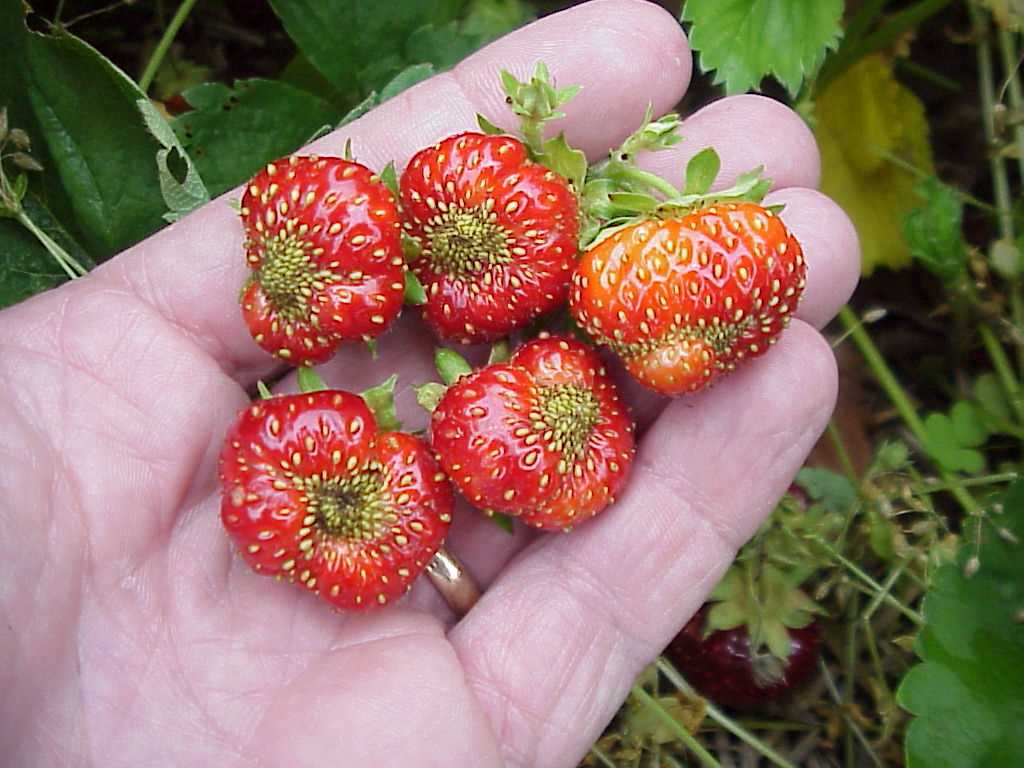
Establishing action thresholds is crucial in IPM as it helps determine when intervention is necessary. Action thresholds are pre-determined pest population levels that, when reached or exceeded, trigger the implementation of pest management strategies.
The threshold levels can vary depending on the specific pest, crop stage, and economic considerations. Some pests may require immediate action, while others may not warrant treatment until their populations reach higher levels.
It is important for growers to be aware of the recommended thresholds for different pests in strawberries. These thresholds can be based on scientific research, field observations, and economic considerations. By diligently monitoring pest populations and comparing them to the established thresholds, growers can make informed decisions about the need for intervention.
In conclusion, regular monitoring and the establishment of action thresholds are integral components of integrated pest management in strawberries. By implementing effective monitoring techniques and staying aware of threshold levels, growers can proactively manage pest infestations and minimize potential crop damage.
Traps and Lures: Pheromone Traps and Sticky Traps
One effective method of controlling pests on strawberries is the use of traps and lures. These tools help to attract and capture pests, reducing their population and minimizing damage to the plants. Two commonly used types of traps are pheromone traps and sticky traps.
Pheromone Traps
Pheromone traps are designed to mimic the natural sex pheromones released by female pests to attract males for mating. These traps consist of a container filled with a sticky substance and a pheromone dispenser. The dispenser releases synthetic pheromones that attract males, causing them to fly towards the trap. Once inside the trap, they get stuck in the sticky substance and are unable to escape.
Pheromone traps are highly effective for capturing male pests, disrupting their mating cycles, and preventing reproduction. By reducing the number of males, the overall pest population can be controlled.
Sticky Traps
Sticky traps, also known as adhesive traps or yellow traps, are another popular method of pest control. These traps consist of a yellow-colored sticky surface that insects are attracted to. The pests get stuck on the sticky surface when they come into contact with it.
Sticky traps are effective for capturing a wide range of pests, including aphids, thrips, whiteflies, and fruit flies. They can be hung around the strawberry plants or placed on the ground to capture crawling insects. Regularly checking and replacing the traps is important for maintaining their effectiveness.
Using Traps and Lures for Integrated Pest Management
Traps and lures can be used as part of an integrated pest management (IPM) strategy for strawberries. IPM involves using multiple control methods to reduce reliance on chemical pesticides and minimize negative impacts on the environment.
When using traps and lures, it is important to monitor the traps regularly to assess pest populations and determine the need for control measures. Traps should be placed strategically, considering the pest’s behavior and movement patterns.
It is also important to use traps and lures in combination with other control methods such as cultural practices (e.g., crop rotation, weed management), biological control (e.g., beneficial insects), and targeted pesticide applications when necessary. By using a combination of control methods, growers can effectively manage pests while minimizing environmental impacts and maintaining the health of their strawberry crops.
Companion Planting: Deterrent Plants and Attractant Plants
Companion planting is a gardening technique that involves planting certain plants together to enhance their growth and repel pests. In the case of strawberries, companion planting can help deter pests and attract beneficial insects, resulting in healthier plants and higher yields. Here are some examples of deterrent plants and attractant plants that can be used in companion planting with strawberries:
Deterrent Plants:
- Marigolds: Marigolds have a strong scent that repels many pests, including aphids and nematodes. Planting marigolds around strawberries can help protect them from these common pests.
- Borage: Borage is known for its ability to repel pests like tomato hornworms and cabbage worms. Planting borage near strawberry plants can help deter these insects and keep the strawberries safe.
- Lavender: Lavender has a strong aroma that can repel pests such as moths and fleas. Planting lavender near strawberries can create a natural barrier against these pests.
Attractant Plants:
- Lupines: Lupines are known to attract beneficial insects like ladybugs and lacewings, which feed on common strawberry pests like aphids and spider mites. Planting lupines near strawberries can help attract these beneficial insects to the garden.
- Nasturtiums: Nasturtiums attract aphids, which can be a common pest in strawberry plants. By planting nasturtiums near strawberries, aphids may be drawn away from the strawberries and onto the nasturtiums, reducing the damage to the strawberry crop.
- Yarrow: Yarrow is another plant that attracts beneficial insects, such as ladybugs and hoverflies. These insects prey on pests like aphids and thrips, which can cause damage to strawberry plants. Planting yarrow near strawberries can help attract these beneficial insects and protect the strawberries from pests.
Companion planting with deterrent and attractant plants can be an effective strategy for managing pests in strawberry plants. By carefully selecting and arranging these plants around strawberries, gardeners can create a more balanced and pest-resistant ecosystem in their gardens.
Question-answer:
What are the common pests that attack strawberries?
Common pests that attack strawberries include aphids, slugs, snails, spider mites, thrips, and strawberry bud weevils.
Are there any organic methods to control pests on strawberries?
Yes, there are several organic methods to control pests on strawberries. These include using organic insecticidal soaps, introducing beneficial insects like ladybugs and lacewings, using neem oil, and practicing crop rotation.
What are some effective chemical treatments for pests on strawberries?
Some effective chemical treatments for pests on strawberries include insecticides containing pyrethroids, which target aphids and spider mites, and molluscicides like metaldehyde, which help control slugs and snails.
How can I prevent pests from attacking my strawberries?
To prevent pests from attacking strawberries, you can use physical barriers like netting to keep out insects, remove any weeds or plant debris near the strawberry plants, regularly inspect the plants for signs of pests, and practice good garden hygiene.
Are there any natural predators that can help control pests on strawberries?
Yes, there are natural predators that can help control pests on strawberries. Ladybugs, lacewings, and predatory mites are just a few examples of beneficial insects that feed on pests like aphids, mites, and thrips.







